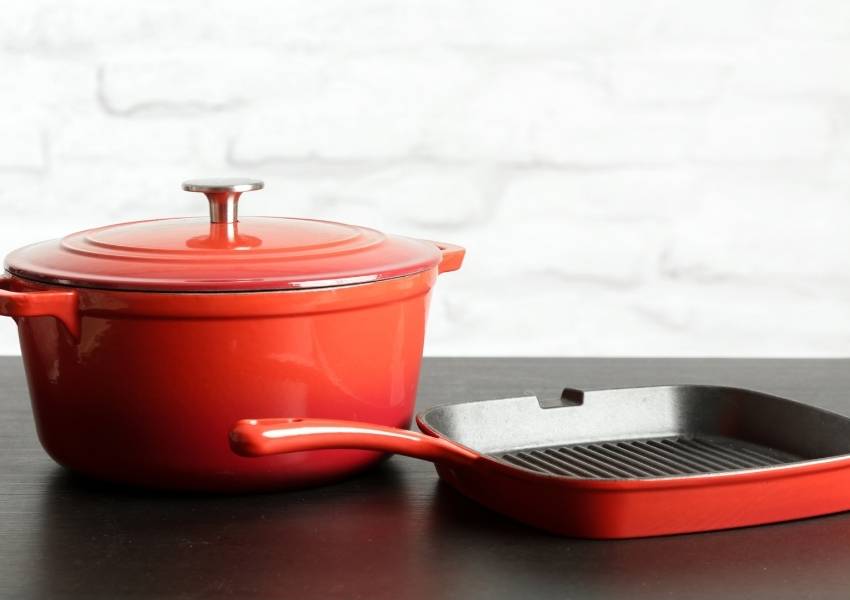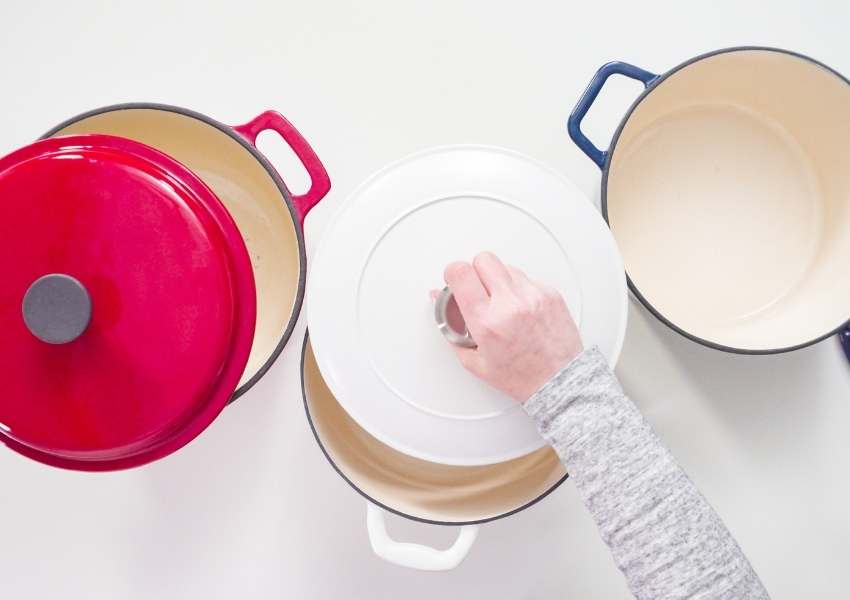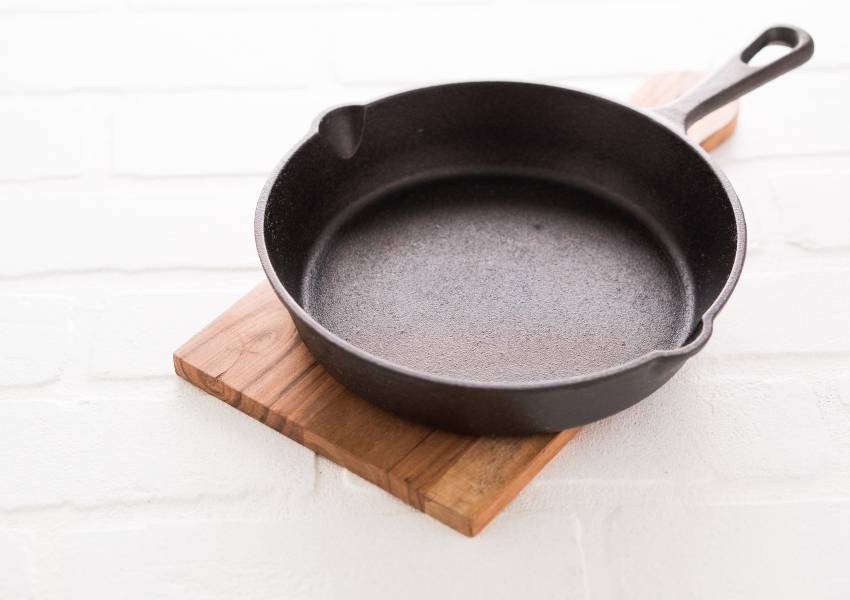Cast iron cookware has been used for centuries.
But what’s the difference between bare cast iron and enameled cast iron, and which one is better?
In this blog post, we'll talk about the differences between enameled cast iron cookware and traditional cast iron skillets. We will also discuss the pros and cons of each type of cookware.
What is Cast Iron Cookware?
Traditional cast iron cookware is made from, well, cast iron, which is an iron alloy. It is a very durable material that can last for decades if properly cared for.
Cast iron is a great conductor of heat, which makes it ideal for cooking. It can be used on all types of cooktops, including induction, gas, electric, and even campfires.
One downside to cast iron is that it is susceptible to rusting if not properly seasoned or cared for.
What is Enameled Cast Iron Cookware?
Enameled cookware is made from the same material as bare cast iron cookware. The difference lies in the extra enamel coating.

The enamel coating protects the cast iron from rusting and makes it easier to clean than traditional cast iron skillets.
It also doesn’t require as much seasoning, although it is still recommended.
The enamel coating also gives the cookware a smooth surface, which prevents sticking.
However, the enamel coating can chip if not properly cared for.
Now that we know the difference between enameled cast iron cookware and uncoated cast iron cookware, let’s take a look at the pros and cons of each.
Enameled Cast Iron Cookware Pros and Cons
Pros:
1. Rust-Free
Enameled cast iron is rust-free, as long as the enamel is not damaged. This makes it a great option for those who are looking for an alternative to uncoated cast iron cookware.
2. Toxin-Free
The enamel coating of enameled cast iron cookware is non-reactive, which means that it does not release toxins into your food.
3. Great Heat Retention
Enameled cast iron cookware retains heat very well thanks to the enamel coating.
4. No Seasoning Required
Although you can season enameled cast iron, it's not necessary the way it is with regular cast iron.
5. Compatible with All Heat Sources
Enameled cast iron is compatible with all heat sources, including induction cooktops, grills, and ovens.
Cons of Enameled Cast Iron
1. Heavy
Enameled cast iron is heavy, just like regular cast iron. However, there doesn't seem to be any significant weight difference between the two.
2. Can't Handle High Heat as Well
Even though it retains heat better, enameled cast iron can't handle high heat as well as regular cast iron.
3. No Metal Utensils
In order to protect the enamel coating, you should avoid using metal utensils on enameled cast iron cookware. Instead, use wooden or silicone utensils.
4. Non-Stick Isn't Great
The non-stick properties of enameled cast iron cookware aren't as good as seasoned cast iron cookware.
So, even though seasoning isn't required to protect enameled cast iron against rusting, it is still recommended if you want the best non-stick performance.
5. Cost
Enameled cast iron cookware is more expensive than regular cast iron cookware. Still, it's a worthy investment, since it will last a lifetime with proper care.
Regular Cast Iron Pros and Cons
Now that we've looked at the pros and cons of enameled cast iron, let's compare it to regular cast iron cookware.

Pros of Cast Iron Cookware
1- It's Cheaper
Cast iron cookware is almost always cheaper than enameled cast iron. If you're on a budget, this is definitely the way to go. You can find a great cast iron skillet for under $50.
2- It's more heat-conductive.
This is because cast iron has a higher carbon content than enameled cast iron. This means that it heats up faster and more evenly, which is great for cooking.
3 - It can handle higher temperatures.
If you're looking to do some serious cooking, cast iron is the way to go. It can handle higher temperatures than enameled cast iron, so you can sear meats and do other intense cooking techniques.
Cons of Regular Cast Iron Skillets
1 - It requires seasoning
This means that you have to season your cast iron skillet before you use it. This is a process of coating the pan with oil and then heating it, which creates a non-stick surface.
If you don't season your cast iron skillet, it can rust, and be difficult to use.
Enameled cast iron generally doesn't require seasoning, so it's easier to use.
2 - It's reactive
This means that cast iron can react with acidic foods, such as vinegar and tomatoes. This can give your food a metallic taste and an off-color. Enameled cast iron is non-reactive, so this isn't an issue.
3 - The color
While there's nothing wrong with the classic black color of a cast iron skillet, there's something to be said about having the choice of many colors.
Enameled cast iron skillets come in a variety of colors, so you can find one that matches your kitchen.
Not only that, but it's easier to check on the progression of your food with light-colored cookware.
With black cast iron pans, it can be a bit harder to tell if your meats are the right color, or if the bottoms are burnt.
Frequently Asked Questions About Enameled Cast Iron Cookware
Does Enameled Cast Iron Add Iron to Food?
You may have read our article on the safety of cast iron cookware, in which we discuss how much iron is released into food when using a cast iron skillet.
With enameled cast iron cookware, there is even less iron released into food than with regular cast iron.
So, if you're looking for a way to add a bit more iron into your diet, regular cast iron is a better option.

Can I Use Enameled Cast Iron on an Induction Cooktop?
Yes, you can use enameled cast iron on an induction cooktop. In fact, it's one of the best materials to use on this type of stove.
The enamel coating helps protect the pan from scratches, and the smooth surface ensures that there are no hotspots when cooking.
What's the Best Way to Clean Enameled Cast Iron?
Enameled cast iron is very easy to clean, similar to cleaning regular cast iron skillets. You can use soap and water, but don't put it in the dishwasher.
You should avoid using abrasive cleaners or scrubbers, as this can damage the enamel coating.
If you do get food stuck on your pan, you can use a little vinegar to help loosen it up.
Making the Decision: Enameled Cast Iron vs Cast Iron Skillet
So, what's the decision? Enameled cast iron or regular cast iron?
The answer depends on what you're looking for in a skillet. If you want the classic look and feel of cast iron, go with regular cast iron.
If you're looking for something that's easier to use and clean but a bit more costly, go with enameled cast iron.
Either way, you can't go wrong with either type of cookware. They both have their pros and cons, but will give you great results. Thanks for reading!